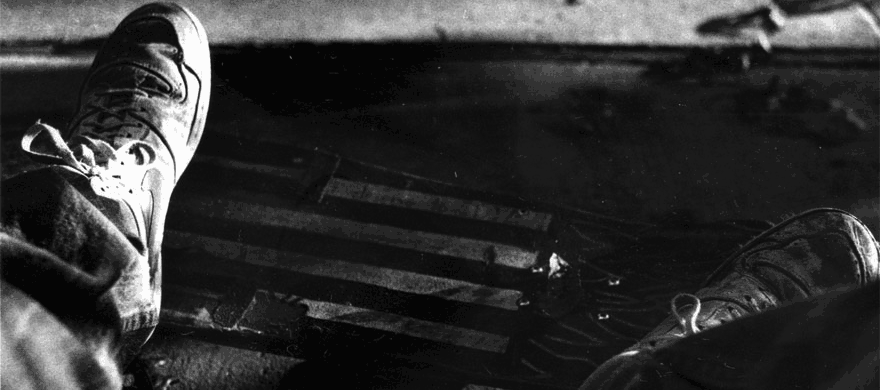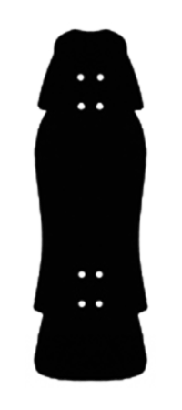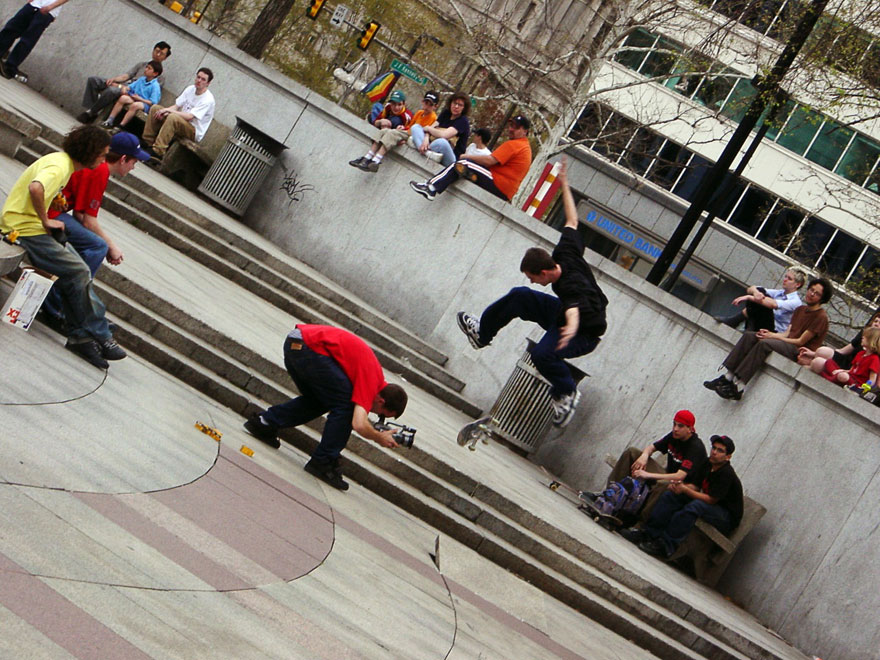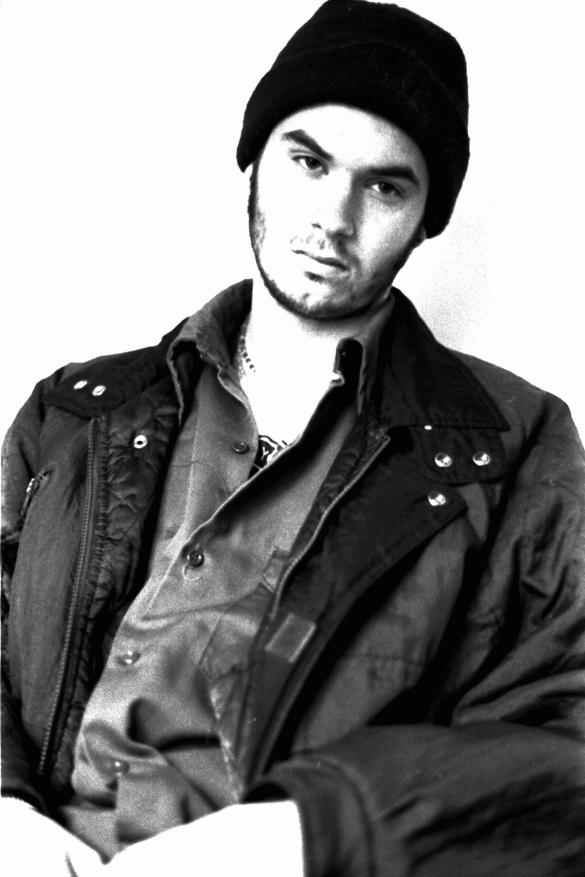
I moved to Philadelphia to attend college in August of 1992. By 1993 I had all but stopped skateboarding. If I had continued to skate, this post would most likely be called Philadelphia, or maybe even Love Park and it would be followed by a post called FDR. I have a fair amount of regret that this is not the case and that this is instead about quitting. It’s been hard to write, as there is no one reason I stopped skating, so I’ve tried to analyze the various contributing factors.
There were signs from fairly early on that I was losing interest in skateboarding. At some point in high school I stopped paying attention to what decks I rode. I remember my earliest boards vividly. The first was some garbage board from a local department store, below even the oft-ridiculed Nash Executioner. My first “real” deck was a red Powell Peralta Tony Hawk and after that, I had a Vision Jinx. At the height of the silly shape phase, I ordered a custom blank deck from an ad in the back of Thrasher Magazine. What I designed had all of the most extreme features of the time, the Hosoi hammerhead, an exaggerated fishtail and hooks similar to the Walker Mark Lake Nightmare. Needless to say, it was ridiculous and by the time it arrived I was already slightly embarrassed by the excess of it all. I went for a more basic and understated shape after that and bought a Blockhead Jim Gray. Beyond that, I have no memory of what I rode. Jeff B was sponsored by our local skate shop, Island Dreams, and for the rest of high school I took his used boards instead of spending my hard-earned lawn mowing money on new decks. A board was a board. That may seem practical but the truth is that I had stopped caring. When I entered college, I was still riding a heavily chipped fishtail shaped deck. That was well out of fashion by late 1992. I hadn’t cared enough to make the transition to what we, at the time, called “double kicktail” boards. I only ended up with one because one of the first friends I made at college, Roy, gave me his old deck. It was scratched up enough that I couldn’t tell what brand it was but I suspect it was a Blind, or one of the other World Industry brands, since they were early off the bat with the modern popsicle shapes.

Re-creation of the shaped deck I designed. Reworked from Mike Giant’s Class Shapes Skateboard Print.
The college I went to was a small art school. Being creative and of the Bones Brigade generation, many of the other incoming students were skateboarders and like me almost all of them would also quit skating during our freshman year. We skated the parking lot together a few times and then all quickly fell off. Every once a while someone would suggest we skate and we would go do flatground tricks or ollie to stalls on these small brick ledges for about a half an hour, but that was it. I can pinpoint the exact moment I quit. One night, early that autumn, I decided to go out by myself to skate the parking lot of a nearby mall. This wasn’t technically the last time that I skated and I didn’t make a conscious decision that evening to stop, but it was the last time that I, under my own volition, chose to go skateboarding. I don’t remember why I went out alone that night. Maybe I was bored? Maybe I felt guilty that I hadn’t been skating very much? What I do remember is how I felt once I was there. I did a few lip tricks on some curbs, tried and failed a few flip tricks on flat and very quickly became overwhelmed with disillusionment and frustration. I doubt I skated longer than fifteen minutes. I was trying to force myself to have fun doing something that I no longer enjoyed.
Around a year later, an upperclassman named Joe built a roughly five foot high steel mini ramp in the field of our school as a sculpture project. Only one side had a deck, which annoyed me both as an artist and as a skater. Why leave something unfinished like that when it was so close to being good? He probably just ran out of time or materials but it was still frustrating. I skated it, as best I could with only one deck, but I turned my ankle after just a few runs. That is technically the last time that I skated. I kept the board Roy had given me for years after. I didn’t discard it until I moved to New York in 2003, but besides some carpet manuals, that crappy ramp is the last thing I actually skated.
I have a good memory of my last real session though. During the winter break of our freshman year, a friend’s friend was visiting us in the dorms and had a car. Someone suggested that we go to Cheapskates, which was a large indoor ramp park north-west of Philadelphia, not too far from my school. I had been to Cheapskates several times during high school and really liked the place so I readily agreed. My college friends spent the majority of that night skating the street course and the micro mini ramp . What I skated was the much larger mini and, more importantly, the bowl that it spined in to. I don’t have any photos of that bowl but some roughly contemporaneous video can be seen here. As I talked about when I discussed Lansdowne, I had always aspired to be a bowl skater but never had access to them. Cheapskates was the only one and, therefore, I was determined to skate it, even it was challenging. I initially struggled to get my basic tricks back on the mini and then fought to get a rock ‘n’ roll on the big wall of the bowl. I pounded my head against that all night until I finally made one. I had some line I was working on, of course I can’t remember exactly what now but I’m sure it was something like 50-50s in the mini, transfer into the bowl, carve around it a time or two and then r’n’r the vert wall. Nothing special, but I got it. I came out of there that night feeling elated and remember saying how surprised I was that I skated as well as I did, having not been on the board for months.
Which raises the question, why then did I quit? I obviously still took pleasure in skating. It seems so strange now, thinking back on it, that within the span of just two or three months I completely stopped doing the activity that had defined my life for the previous eight years. I had been a skater. That was my identity throughout middle and high school. While I had a variety of other hobbies, skateboarding was, without doubt, what I spent the majority of my time doing.
In some ways the reason I quit is simple, I just became interested in other things. Much like how I lost interest in comic books and Dungeons & Dragons as I became a teenager and discovered skateboarding and punk rock, I lost interest in skateboarding when I became an adult. It wasn’t that I felt that skateboarding was childish and now it was time to put away childish things. It wasn’t a decision I made, it was organic. As other things in my life took precedence, I let skateboarding fall by the wayside.
That first year of college, I had a series of intense and tumultuous relationships. Roy was in a band and through him I made a number of friends and became part of the Philadelphia punk scene. We went to shows constantly. Most importantly though, the foundation year of art school was a lot of work. I often joke that I went to art school to major in drugs and group sex but that hedonism didn’t really take hold until later in college. So while I drank 40s, smoked weed and rapidly cycled through girlfriends that first year, it was also, intellectually and artistically, an incredibly busy and stimulating time. Unlike high school, I simply didn’t have much time to skate. I went all in and fully committed to being an art student. I stopped identifying as a skater and began identifying as an artist. The jaded and nihilistic partying didn’t really set in until near the end of my time at school, though I’d be lying if I said drugs and alcohol didn’t have something to do with my quitting as well.
As I talked about in my Ocean City post, the summer before college we went to the beach for Senior Week and we didn’t skate, I don’t even know if we took our boards. What I did there was drink and get high for the first time. Partying was the priority, trying in vain to meet girls was secondary, skating a distant third. After that trip I began to smoke weed more often. That final summer before college, we used to hang out at night and skate a curb in front of the Blockbuster. It was a nice slick red curb but why we chose to skate there, and not the slick red curb in front of the crafts store for example, was because, back then, the Blockbuster was happening. We would see people we knew and would try to talk to random girls. We turned it in to our hangout spot, a place to kill time and meet people. Skating was just the excuse. The night I bought my first bag of weed, I smoked a bowl, put my headphones on and skated over there. That marked a transition point. I wasn’t there to skate, I was there to listen to my music and hang out with my friends.
While my passion for skateboarding was obviously fading, I think the reason that I quit so abruptly was that, at college, there was nothing to skate. I lived in Philadelphia from 1992 until 2003, which almost perfectly corresponds to the years when Love Park was one of the premier spots in the world. So it may seem silly for me to say there was nothing to skate, but from where I lived, Love may as well have been in a different city. I didn’t move downtown until 1996. For four years I lived by my school, at the northern tip of the city. There was nothing to skate up there except flat in empty parking lots. Nothing. I didn’t have a car and to get downtown involved a long wait for a bus to train. Since I had only ever been in Philadelphia once before, I also didn’t know the city at all. I didn’t know Love was a “thing”. I had no idea where to go. My one and only attempt at exploring North Philly for spots resulted in bottles thrown at me and a pit bull let off its leash to chase me as I bombed a hill. After that, I stayed near my school and skated flat and that was not the kind of skating that I wanted to do. Even if I had lived near Love, I doubt I would have skated it much. I had huge misgivings about my ability and was frustrated by my lack of progression. The guys skating Love at the time were future pros that would go on to set the tenor of street skateboarding for the next decade. I can guarantee that I would have been too embarrassed, intimidated and self-conscious to skate there without knowing anyone. Without friends and encouragement, I would not have tried to insert myself into a scene like Love, especially during the infamously unfriendly ’90s. I would have been a complete outsider and undoubtedly one of the worst skaters there. I had always been middle of the pack, ability wise, but by 1992, the pace of innovation was absolutely staggering and I was rapidly being left behind. Marc, writing about skate videos on his blog, talked about this more eloquently than I can.
[It] culminat[ed] with Plan B’s Questionable in 1992. This last sounded the death knell for many of us at the time, I believe. Watching it again, it seems clear that we recognized that what those guys – Mike Carroll, Pat Duffy, Danny Way, Rodney Mullen, etc… – were doing had gone so far beyond what we could realistically hope to emulate, had become such a terrifying mix of technical prowess and sheer courage, that there was almost no point in trying to keep up with them. Skating had moved beyond us, had left us out in the East Coast cold. Unless you were willing to risk your very life for the lens, you were out. Skateboarding had become – perhaps always had been – a kind of poker. The ante was high, too high, and I folded.

Source: Robert Francis Flickr. Love Park in the early 2000s.
Marc recently found a video of Mike Vallely echoing those exact sentiments, which just shows how fast skateboarding was developing. Only a year or two prior Mike V had been one of the best street skaters in the world. It was his football shaped barnyard deck that inspired the shift to popsicle shaped decks. If he felt outpaced, I didn’t stand a chance. I couldn’t keep up with the progression in street skating and my transitions skills had plateaued as well. I had my handful of tricks but I had not learned anything significant in years. Most frustrating to me was that I lost many of those tricks once a ramp was over five feet high. As I talked about in my mini ramp post, the summer before I went to college my friends built their best ramp yet and I didn’t skate it because it was too big for me and the one and only time I went Bucky Lasek was there and I was too embarrassed. Still though, I preferred to skate transition, it was what I was best at. If FDR had been around back then (and accessible, since it would have been even farther away from me than Love) there is a chance I would have stayed in the game a bit longer. FDR would have been too appealing for me to resist. That was the type of park that I had always wanted to skate. In the years after college, I would sometimes ride my bike down there to check out how the construction was going. I would stop at Love briefly as well, whenever I was downtown, to watch the kids skate. I didn’t forget about skating, I just didn’t do it anymore.
While I quit because I developed other interests, didn’t have anything to skate and was frustrated by my ability level, I think what hit me the hardest was the loss of my skate crew. Without my group of friends, I lost the motivation to continue skateboarding. I did not have the monastic dedication it took to, like Rodney Mullen, go skate an empty parking lot alone at night and try to learn new tricks. Even at the height of my teenage skateboarding obsession, I rarely skated alone. I would mess around on the quarterpipe in my backyard when bored or prowl Ocean City looking for street spots when on vacation but generally skateboarding for me was about “where are WE skating today?” Skating was a social activity. It was about hanging out with my friends all day. There was a group dynamic to it. There was an energy generated by the group. You hyped each other up to try new things and cheered each other on. This is probably the root cause of why I quit. My friends all went off in different directions and I stopped skating because of it. We stayed in touch, as best we could in those pre-internet days, but we never skated together again.
I recently asked them about their experience with quitting.
Ed
I had mostly stopped by the end of high school, probably before senior year. I had really enjoyed riding mini-ramps but by that time it had mostly switched to street skating. Truth be told I was scared shitless of handrails and trying to learn kickflips was impossible. Street skating was not for me so I gradually stopped. I don’t really remember a last time per se, but I do remember I didn’t even buy my last board. I think it was given to me by Jeff B when my last one shit the bed.
Marc
I went to VCU in Richmond, VA from 1992 to 1994. I skated the first year I was there. I used to skate the campus outside the dining hall. There was a nice pedestrian plaza with some flat, ledges and curbs. There was a big gap we’d always try to ollie, but I never made it. There were other skaters, mostly freshmen like myself. Sometimes we’d go downtown and skate the city at night. I don’t remember consciously quitting, but I do remember my interest in other things eclipsing my interest in skating. I began collecting records, listening to music with real interest, and reading books. I suppose skating just began to feel a bit less sophisticated than I wanted to be. I have no memory of a “last” time skating. I think by the end of my freshman year I was definitively finished, though.
Young
I went to UMBC for my undergrad and masters. I skated Lansdowne, which was close to campus. I skated solo mostly, sometimes with a few other skaters from college and recall I even skated with a middle school friend, Scooter, from when I lived in Lansdowne. My memory of when I stopped is a bit fuzzy. My “current” board is a Foundation Steve Olson from 1993. The trucks are Grind Kings from the 1996-97 era, according to Thrasher ads. I vaguely recall having to drill holes in the deck for the new truck bolt patterns. School work was a big part of why I stopped, but I think I had moved on to mountain biking with friends from college by around 1995-1996 . Eventually, around 1999-2000, I bought my road bike. It was the first year Campy Ergobrain-compatible shifters came out. Road biking, then running consumed my free time… and of course starting my career.
Jeff B
After high school, I continued to skateboard through all six of my years at college. The first two years of college I spent at Towson State University, where I mostly ditched class and ignored homework to skateboard and work at the gas station. The last four years I went to UMBC and while skateboarding was still a big part of my life, I found a balance that made me happy and still allowed for success in school. I would guess that skateboarding started to fade for me about four years after college, but it faded slowly. We would still get out to skateparks every few weeks, but with age, injuries lasted longer and hurt more. The gaps in time between skate sessions increased over the years but I always had skateboards until about three years ago. I had a standard setup and a cruiser with big soft wheels. I gave the standard one to a neighborhood kid and the cruiser was stolen, but that love I had for skateboarding could never be replaced, and I don’t regret one minute of the time I spent on a board. I have a new love for bicycles, but it will never be the same as it was with skateboarding.
This is not the end of my story though. In 2012, at the age of 38 I started skateboarding again. That will be next.


Just discovered this blog today on tip-off from Luchaskate. I’m devouring it. Great stuff.
Thanks!